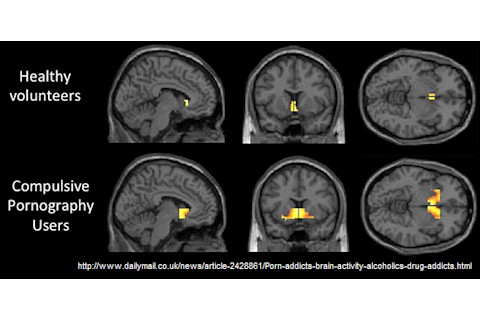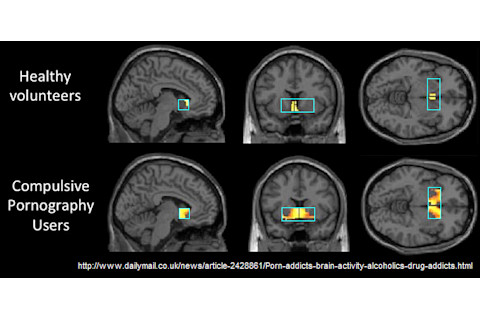Britain's been talking about pornography this week. On Monday, Channel 4 broadcast Porn on the Brain, accompanied by plenty of excited press coverage. Porn is hardly a recent invention. So what's new? It all centres on this:

In an fMRI study conducted at Cambridge University, and discussed in the Channel 4 documentary, healthy controls and compulsive porn users were shown sexual images. The brains of porn users showed more activation - and the region differentially activitated was the reward system, the same area activated by addictive drugs. The media were attracted to those little yellow blobs:
Scan images show that watching online 'adult' sites can alter our grey matter [this is not what fMRI shows in any case], which may lead to a change in sexual tastes
This hasn't been published in a peer-reviewed journal yet, so we can only judge by what we see. First off, the areas of activation are more block than blob, with lots of sharp edges, unusual for fMRI. The brain is not made of lego, so you don't expect to see corners in there. On Twitter, it was suggested that it might just be an honest reflection of the fact that fMRI images have less resolution than structural images (the grey brain). But the resolution of the blobs is actually pretty high, when you look closely. To me, this suggests that the functional images have been masked, to hide activations outside of a particular, defined region. Here's where I suspect that the mask was - the blue boxes are in the same place on the top and the bottom row. This would explain why some of the edges line up across the two groups.

I might be wrong. Even if I'm right, there's no neuroimaging law against masking. It's a perfectly legitimate technique when used appropriately, but in this case it matters - it might change our interpretation of the differential activation in the porn users, if we could see that it wasn't selective to the reward system. For instance, if the brains of users lit up in the visual cortex, as well as the reward areas, then that might suggest that rather than being addicted to pornography, the users were just looking at it more closely. Perhaps, having seen it all before, they were less prone to averting their eyes than the more bashful controls. Or alternatively, it could be that the users' brain activity reflects the emotions of shame or guilt they feel at being confronted with their weakness - in which case, emotion and self-concept-related circuitsmight well light up too. Or it might be that the users' brain response was just heightened overall because they were breathingly more heavily, causing changes in the blood oxygenation that fMRI uses as a proxy for brain activity. In fact, all of these interpretations are possible even if there wasn't any masking. But supposing there was indeed a selective (and statistically significant) difference in brain response in the reward area - supposing it were proven to be a consequence of porn use and not a preexisting risk factor - where would that leave us? We neuroscientists would get an interesting finding - another data point to ponder in our attempts to figure out what these areas of the brain do. But normal people expecting a 'take home message' will be disappointed because as of yet, we're just not sure what most brain activity means. 'What porn does' is not a question neuroscience can answer yet. A brain scan won't tell us; if anything can, it's one of the few human inventions older than pictures of naked people - observing and thinking about human behaviour.













